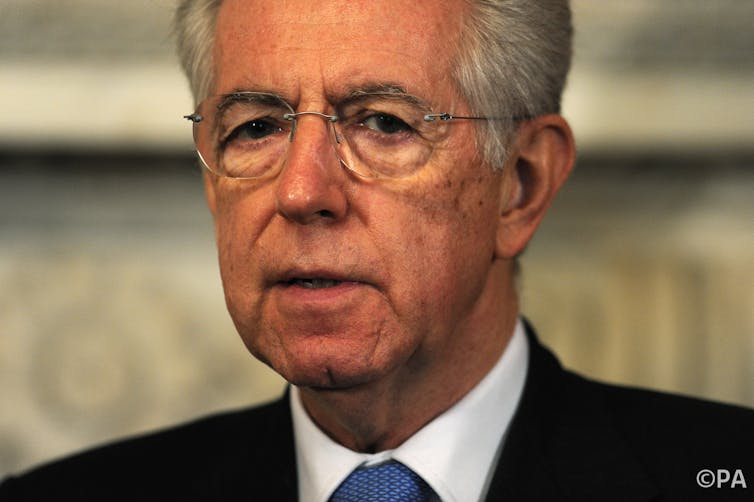
Plamen Oresharski. You might not have heard of him. I certainly hadn’t until a few days ago. But, according to reports, he may become the next unelected, non-party prime minister in Europe. Or the “Bulgarian Mario Monti”, as he is being described in some quarters.
Given Bulgaria’s low profile in the Western media, we’re unlikely to see the flurry of headlines that occurred in November 2011, when Monti became prime minister in Italy at the same time as former vice-president of the ECB, Lucas Papademos, did so in Greece. Then, with nods to George Orwell and Aldous Huxley, we were warned about the sudden invasion of our governments by grey inflexible men, armed with statistics and new rulebooks, usurping democracy from the people and imposing the one-size-fits-all policies of European and global elites.
A piece in the New Statesman was typical, both in its apocalyptic tones and flawed historical analysis. We were told:
For the first time in a generation, European countries are now headed by individuals who have had no popular endorsement at the ballot box.
Nonsense. As Marco Valbruzzi and I showed in a paper we presented at the European Union Studies Association Conference in Baltimore last week, there is nothing new about this. Up until early 2013, there had been 24 governments headed by technocrats in the current 27 EU member states, many of them in previous decades. And almost half of these have been “caretaker governments”. In other words, they have been short-lived administrations put in place to “mind the shop” until new elections can be called and duly-mandated party governments re-installed.
Unfortunately, just to add to the confusion, “caretaker” is often used as a synonym for “technocratic”. For example, both the BBC and the Financial Times referred to Monti’s technocratic government as a “caretaker”. Wrongly so. Not all caretaker governments are led by technocrats (we find them led by party representatives in countries such as the Netherlands and Belgium). But nor are all technocrats caretakers. Monti was put in place not to “mind the shop” for a short period of time, but to gut it and cut it over the course of 18 months. His administration was, as Valbruzzi and I have termed it, a “full technocratic government”. By this, we mean the prime minister was a technocrat, the majority of ministers were technocrats, and the government had the capacity to make major changes such as the introduction of new taxes, pension reforms, liberalisation measures and so on.
The full Monti
Qualitatively, in terms of both its non-party composition and extensive remit, this “full technocratic” (or “full Monti”?) is a very different species of government to a caretaker. But it is a rare one. At least according to our criteria, there have only been three full technocratic governments in the last ten years in EU member states: Monti in Italy (2011-2013), Gordon Bajnai in Hungary (2009-2010), and Jan Fischer in the Czech Republic (2009-2010). To return to 2011, the Papademos government which was constantly bracketed alongside Monti’s was very different: it was composed mostly of representatives from the two largest parties, PASOK and New Democracy. Indeed, 12 of the 18 ministers in the Papademos cabinet had been PASOK ministers in the previous George Papandreou government. By contrast, Monti’s government contained not a single MP or party member – and lasted nearly three times as long. If we want to make an Orwellian reference, of which the commentators in 2011 were so fond, we could say that some technocrats are more equal than others.
None of this, of course, is to claim that governments led by technocrats do not raise important concerns about how our democracies are functioning. They do. In particular, when the key members of a government in a parliamentary system are unelected technocrats, charged with taking major governmental decisions, there is clearly a question mark hanging over the chain of democratic delegation.
Governments composed of technocratic prime ministers and ministers have not been elected on a platform presented to the citizens. And, given that technocrats are not party politicians, they are not – in theory – constrained in their actions by the fear that the voters will throw them out at the next election. I say “in theory”, since technocrats too can be subsequently seduced by the lure of political competition (as we have seen recently with both Monti in Italy and Fischer in the Czech Republic).
However, what should be most worrying about these governments is what they tell us about the political parties in our democracies. Above and beyond the attention-grabbing noise about technocratic invasions, it is important to bear in mind that these governments occur with the consent of mainstream parties. More specifically, they occur when those parties wave the white flag and openly admit that they cannot perform what should be their core business: government.
Indeed, in cases such as Italy, the main parties of centre-right and centre-left abandoned both government and opposition in the face of a technocratic government. They announced to the world their inability to do their jobs. Or, to put it kindly, they took a very public sabbatical. However, that leaves the door open for non-mainstream parties which offer not only opposition, but the promise of restoring responsive democratic government to the people. And these multi-coloured outsiders of Left, Right and no-fixed ideological abode, may be much more dangerous for mainstream parties in the longer term than the grey men. The technocrats so far have been just a trickle. The outsiders look more like a wave.
